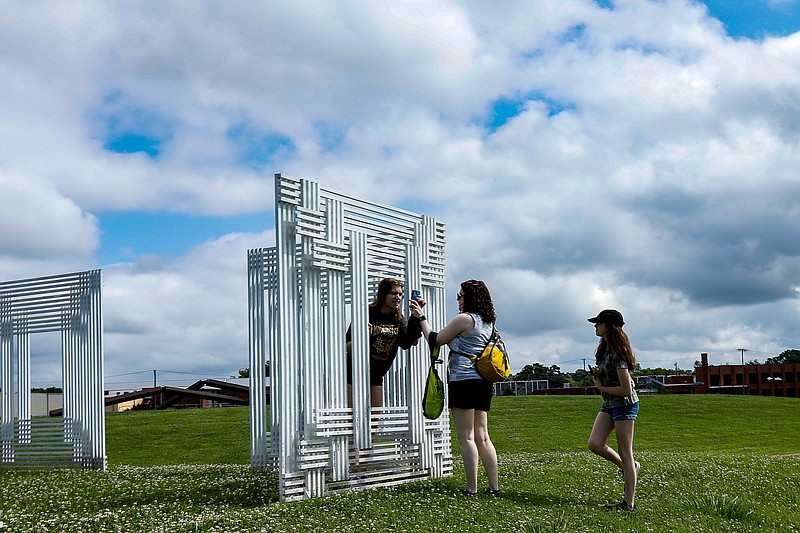A Sculpture Fields at Montague Park supporter says he's worried that a proposal for new athletic facilities at the park could stir up environmental issues at the former landfill.
"For them to do this construction could cost a lot more money than they think and create more of an adverse impact than anyone realizes," said Warren Barnett, a Sculpture Fields board member. "There's no current environmental issue with the 13 acres so long as the three-foot soil cap is not disturbed."
But a city official said the Tennessee Department of Environment and Conservation (TDEC) believes the park can be a safe location for recreational and leisure activity.
Whatever goes on the 13-acre tract, the tenant would be legally bound to contact TDEC to ensure that a soil management plan is in place that's in accordance with state requirements as improvements are made, said Jermaine Freeman, interim administrator for the city's Department of Economic Development.
"The city will defer to TDEC for guidance on this matter, as we do with all sites of this nature," he said.
Next Tuesday, the City Council is expected to consider a proposed 40-year lease of the parcel next to the Sculpture Fields to the Chattanooga Football Club Foundation. The foundation has a multimillion-dollar plan for three multi-use fields for soccer and other sports, a 22,000-square-foot pavilion, restrooms, a concessions area and 180 parking spaces, plans show.
But Sculpture Fields officials have their own $8 million to $10 million plan for the adjacent tract, including new art pieces, a 2,000- to 3,000-seat amphitheater, and a welcome center.
Kim Schofinski, TDEC's deputy communications director, said TDEC and the city continue to monitor activity at the park to ensure that the landfill cap is not compromised by any on-site activities.
"Both the city and TDEC continue to work cooperatively to ensure the integrity of the remedy while encouraging safe reuse," she said.
Barnett said that after Sculpture Fields leased 33 acres from the city in 2012, over 5,000 additional truckloads of dirt were hauled in to reinforce the cap and form the hills that people see today.
Adding such dirt was not done to the 13 acres leased earlier by the Chattanooga Rugby Club before the Sculpture Fields lease was created, he said.
"Pollutants were released when the rugby field was built," Barnett said. "We further know that piercing the three-foot cap for electrical lines, footings for buildings can potentially lead to the ongoing release of pollutants from the garbage below. Such emissions are considered toxic to humans as they are known carcinogens, even at low levels with prolonged exposure."
The Sculpture Fields hired an environmental company to provide an overview of the park, and the firm's president said that a risk assessment ought to be done on the tract that's up for lease.
Maureen Handler, who owns Southern Environmental Technologies in Sewanee, Tennessee, cited the history of the park, noting it was an unregulated landfill from the mid-1940s to the mid-1960s.
The park at East 23rd and Polk streets, which later had held softball fields for years, in 2003 was closed for environmental testing and TDEC determined that the three-foot cap was needed to adequately cover the landfill. In 2013, TDEC declared the land sufficiently capped and ready for use again, according to Handler, who earlier worked with the Sculpture Fields to ensure it was safe.
She said someone will need to look at future design of the proposed athletic fields and, from a risk assessment point of view, make sure the foundation's plans are safely done.
"You may have to bring it up a foot or two," Handler said, so there is sufficient enough cover over the cap on the landfill. "Those risks can be mitigated by the design usually."
In a letter to the Sculpture Fields board, she said it was common at the time the park was made a landfill that waste was burned on a regular basis to provide added space. Investigations at the site have shown low levels of volatile organic chemicals in the groundwater, most likely from chemicals leaching from the waste disposal at the site, Handler said.
She said that monitoring wells were abandoned in 2013 with permission from TDEC.
Handler also said soil sampling performed has shown levels of polynuclear aromatic hydrocarbons (PAHs) throughout the southern portion of the site, which Sculpture Fields officials said the athletic facilities would go. PAHs are formed from incomplete combustion and most likely present due to the burning of waste when the landfill was operating, she said.
Some PAHs were detected at levels above the U.S. Environmental and Protection Agency screening levels for residential soils, Handler said. One PAH was detected above EPA screening level for industrial soil, she said.
Schofinski said that in 2013, all data indicated that monitoring wells were no longer needed and those were abandoned.
"The selected remedy for the site was to supplement the existing landfill cap and place fill material in areas where inadequate capping had been identified," she said.
Contact Mike Pare at mpare@timesfreepress.com or 423-757-6318.
